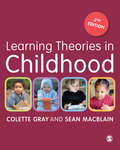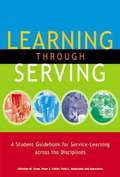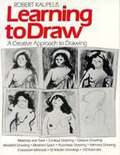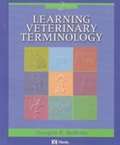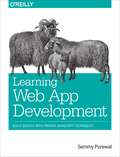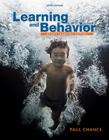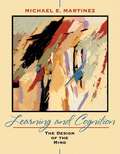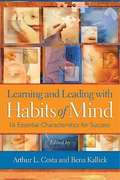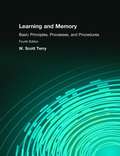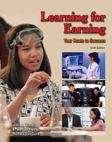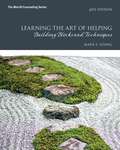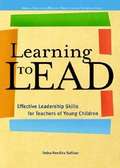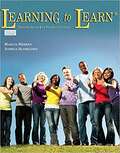- Table View
- List View
Learning Theories in Childhood
by Sean Macblain Colette GrayBy focusing on the early philosophies of learning and the key behavioural, cognitive and social theorists, this book provides a comprehensive overview of children's learning. The authors discuss the key learning theories, highlight the strengths and weaknesses of each approach and encourage reflection on how different approaches impact on the learning environment. The discussion finishes with an exploration of the new sociology of childhood. Examples are drawn from practice to highlight key concepts, and to make vital links between theory and practice.<P><P> Theorists considered include:<P> - Locke<P> - Rousseau<P> - Montesori<P> - Piaget<P> - Vygotsky<P> - Bandura<P> - Bronfenbrenner <P> - Bruner<P> Accessibly written, with key questions and recommended reading included, this book is essential reading for all those studying on child development, early childhood and childhood studies courses, and for anyone interested in understanding more about how children learn and think.<P> Colette Gray is Principal Lecturer in Early Childhood Education at Stranmillis University.<P> Dr Sean MacBlain is Reader in Child Development and Disability at University College Plymouth, St. Mark & St. John.
Learning Through Serving: A Student Guidebook for Service-Learning Across the Disciplines
by Christine M. Cress Peter J. Collier Vicki L. ReitenauerThis book is intended as a self-directed guide for college-level students who are engaged in service-learning. It is also suitable for students working individually.
Learning Through Sounds (Practice Work Book, Grade #2)
by Pathway PublishersA grade 2 language arts practice work book; Learning through sounds.
Learning Through Sounds Grade 1 (Medieval Mysteries #1)
by Pathway PublishersThis workbook has been prepared especially for first graders in Amish parochial schools. Pictures have been carefully chosen to be of objects the average Amish child is familiar with. Not only was the book prepared with the children in mind, their teacher was also considered. Though children need a certain amount of teacher help to master the skill of sounding out words, this workbook has been designed so that the children will soon be able to work without much teacher assistance. You will notice there are no instructions included with the exercises in this book. You will find detailed instructions, plus a wealth of supplementary exercises in the 'Teachers' Manual for Grade One Readers." We would like to encourage teachers to follow the instructions given in the manual, then let their own imagination and that of the children lead them in deeper and more detailed lessons in phonics.
Learning Through Sounds Grade 1 Book2
by Aylmer Ontario Bloomingdale MichiganThis workbook has been prepared especially for first graders, to follow LEARNING THROUGH SOUNDS, Book 1. All the sounds taught in Book 1 are reviewed on the first pages of this workbook, and then the consonant blends, long vowels, consonant and vowel digraphs, and some of the diphthongs are introduced and taught. Great care was taken to reinforce and review each sound repeatedly, but no workbook can take the place of daily drilling. The teacher is encouraged to work with her pupils until they recognize each sound automatically the instant they see it.
Learning To Draw
by Robert KaupelisFull of inventive and stimulating projects designed to develop observation skills and creativity, this book approaches drawing as a process of personal discovery through improvisation. Richly illustrated with drawings by old and modern masters.
Learning Veterinary Terminology (Second Edition)
by Douglas F. McbrideThis text is newly updated to reflect the latest terminology and features numerous new and revised pedagogical features that make it an excellent resource both in the classroom and for self-study. Brand-new additions include several new appendices, new anatomical drawings, and a more extensive index. Many sections have been completely rewritten for consistency and greater reader comprehension, and review sections now include more thought-provoking questions and multiple-choice tests.
Learning Web App Development
by Semmy PurewalGrasp the fundamentals of web application development by building a simple database-backed app from scratch, using HTML, JavaScript, and other open source tools. Through hands-on tutorials, this practical guide shows inexperienced web app developers how to create a user interface, write a server, build client-server communication, and use a cloud-based service to deploy the application. Each chapter includes practice problems, full examples, and mental models of the development workflow. Ideal for a college-level course, this book helps you get started with web app development by providing you with a solid grounding in the process. Set up a basic workflow with a text editor, version control system, and web browser Structure a user interface with HTML, and include styles with CSS Use JQuery and JavaScript to add interactivity to your application Link the client to the server with AJAX, JavaScript objects, and JSON Learn the basics of server-side programming with Node. js Store data outside your application with Redis and MongoDB Share your application by uploading it to the cloud with CloudFoundry Get basic tips for writing maintainable code on both client and server
Learning Web Design with Adobe CS3: Dreamweaver, Fireworks, Flash
by Katherine MurrayNIMAC-sourced textbook
Learning and Behavior: Active Learning Edition (6th edition)
by Paul ChanceThis undergraduate textbook introduces the natural science approach to behavior and describes the efforts of researchers to understand the kinds of experiences that produce learning, the circumstances under which learning in one situation carries over to another situation, the effects of different reinforcement schedules, the durability of learned behavior, and the limitations of learning.
Learning and Cognition: The Design of the Mind
by Michael E. MartinezWhat is the design of the mind? What does that design imply for education? This comprehensive and engaging introduction to human learning and its applications to education focuses on these vital questions by exploring the theories of knowledge, complex cognition, and human intelligence, presenting a clear and interesting overview of the human mind through multiple theoretical lenses. The author delineates how the mind has a clear design, or architecture, that explains simple acts of memory and complex cognition, to highly creative acts and leaps of scientific or artistic insight. Topics covered throughout the text include: memory, motivation, cognitive development, the brain, and intelligence. Unique to this text, the author has provided an interdisciplinary chapter dedicated to theories of knowledge, extended coverage of expert-novice differences and talent development, and a chapter devoted to intelligence. Readers will appreciate special features like Learning Strategies which cover specific application of the theories to classroom practice, and Interest Magnets which explore fascinating topics such as photographic memory, sleep learning, and Einstein's brain. Written like a narrative, Learning and Cognition: The Design of the Mind will delight its readers' interest and attention as they learn about the theories of human learning and cognition and the improvement of the mind through education.
Learning and Leading With Habits of Mind: 16 Essential Characteristics for Success
by Arthur L. Costa Bena KallickIn Learning and Leading with Habits of Mind, noted educators Arthur L. Costa and Bena Kallick present a comprehensive guide to shaping schools around Habits of Mind. The habits are a repertoire of behaviors that help students and teachers successfully navigate the various challenges and problems they encounter in the classroom and in everyday life. The Habits of Mind include: Persisting, Managing impulsivity, Listening with understanding and empathy, Thinking flexibly, Thinking about thinking (metacognition), Striving for accuracy, Questioning and posing problems, Applying past knowledge to new situations, Thinking and communicating with clarity and precision, Gathering data through all senses, Creating, imagining, innovating, Responding with wonderment and awe, Taking responsible risks, Finding humor, Thinking interdependently, Remaining open to continuous learning.
Learning and Memory: Basic Principles, Processes, and Procedures (4th Edition)
by W. Scott TerryThis text explores the core principles of learning and memory in a clear, reader-friendly style, covering animal learning and human memory in a balanced fashion.
Learning and Memory: From Brain to Behavior (Second Edition)
by Mark A. Gluck Eduardo Mercado Catherine E. MyersDevelopments in neuroscience have changed the field of learning and memory significantly in the last ten years. This comprehensive introduction to learning and memory covers behavioural processes, brain systems, and clinical perspectives.
Learning for Earning: Your Route to Success, 6th Edition
by John A. Wanat E. Weston Pfeiffer Richard Van GulikLearning for Earning presents the skills students need to succeed in school, on the job, and on their own. Teacher's Wraparound Edition provides teaching aids in the page margins for reviewing and reinforcing text content plus challenging activities that extend learning. The text includes a running glossary to highlight new terms presented in the chapters.
Learning the Art of Helping: Building Blocks and Techniques (Sixth Edition)
by Mark E. YoungStudents and beginning counselors get step-by-step guidance for developing the skills and techniques they need to effectively help their clients. This sixth edition of the best-selling Learning the Art of Helping: Building Blocks and Techniques emphasizes the techniques and skills necessary to be effective in the art of helping, from basic building blocks to advanced therapeutic techniques. The text is practical, innovative, and focused on the relationship between helper and client. The author incorporates the latest research on effective treatments, while offering an integrative perspective. The author's conversational tone is appealing to students, yet the book is carefully referenced for instructors. The goal is to make beginning helpers become "reflective practitioners. " "Stop and Reflect" sections, exercises, homework, class discussion topics, and Journal Starters support this approach. The sixth edition includes new sections highlighting issues of culture in research, challenges related to gender differences, and helping skills specific to children.
Learning to Lead: Effective Leadership Skills for Teachers of Young Children
by Debra Ren-Etta SullivanDiscover the natural leader inside of you! Everyone who works with children is a teacher and a leader. An in-depth look at how leadership skills impact all areas of early childhood care and education, Learning to Lead combines accessible leadership theory and practice with important topics and issues such as human development, diversity, anti-bias, work with families, and social change. Each chapter is built around a combination of theories, examples, and reflection questions - all designed to prompt self-evaluation and personal leadership development. Learning to Lead is a must-have resource for early childhood teachers at all levels.
Learning to Learn: Thinking Skills for the 21st Century
by Marcia Heiman Joshua SlomiankoLearning to Learn is the only college-level program the Department of Education has found to have valid, controlled studies showing significant, lasting impacts on students grade point averages and retention through graduation. These studies show 80% graduation rates at colleges and 20% improvement in retention at four-year colleges. The skills in this book come easily to students because they re built on natural learning skills the skills used every day. Learning to Learn brings back the feeling of excitement about learning new things that students had before school and tests. They learn to build on their natural questioning skills and translate back and forth between what they see and what they think about between verbal and visual learning.
Learning, 5th Edition
by A. Charles CataniaThe 5th Edition surveys the major areas in the psychology of learning from a consistent behavioral point of view. Learning explores the continuities between human learning and the learning of other animals. The book organizes the phenomena of learning in a systematic way, moving from Behavior Without Learning (evolution) to Learning Without Words (basics in nonhuman behavior and learning) to Learning With Words (human learning and memory).
Leave Rules Made Objective
by Muthuswamy Brinda SanjeevThe questions in this book have been framed in such a way that no rule is left untouched. All possible questions that can be asked from the CCS (Leave) Rules have been visualized and extracted by our team of assistant authors and incorporated in this book. The answers to the questions have been given as a key at the end of the book. For a detailed explanation of the key, readers are requested to go through the relevant Rule, Office Memorandum or GID, quoted against the Key, from Swamy s Compilation of FR & SR — Part-Ill— CCS (Leave) Rules.
Leaving a Mark (Fountas & Pinnell Classroom, Guided Reading Grade 3)
by Michael Sullivan Monica AuriemmaNIMAC-sourced textbook
